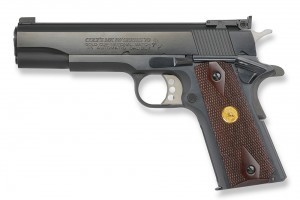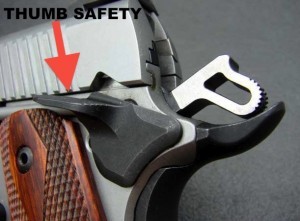How To Write Realistically About Guns: Safeties
Almost every author I’ve read feels compelled to have their gun wielding characters switch off the safety after the weapon has been introduced into the scene. The gesture is irresistible to writers because it increases dramatic tension. It’s often the last bit of narration before the trigger is pulled. However, few authors seem to be aware of the fact that many of the guns they have unholstered in their writing are manufactured without external safeties.

Lt. Col. Dave Grossman’s Endorsement of PATRIARCH RUN
This installment in the series of How To Write Realistically About Guns will focus on the thumb safety, the mechanism the vast majority of authors intend to refer to when they have a character switch off a gun’s safety. Below is an image of a 1911 handgun beside a close-up image of its thumb safety.

1911 with thumb safety

thumb safety
It’s called a thumb safety because the operator uses their thumb to push it down (off) or up (on). With this particular weapon, the current fashion is to grip the gun and ride your thumb on top of the safety. To take off the safety, the operator pushes their thumb down.
Although there are many different types of thumb safeties, the action described above is an approximation of what most writers intend when they have a character switch off a safety in preparation to fire a handgun.
Here’s the Problem
Some of the most popular handguns being manufactured today have no thumb safety. As a matter of fact, they have no external safeties at all. There’s a good reason for this. The human stress response is such that manipulating a thumb safety in a gunfight can be difficult, so difficult that it can get you killed.
If that fact seems bizarre it’s because you haven’t yet been in a situation in which your body has involuntarily reacted to that type of stress. I’ll address those physiological and psychological realities in a later post.
Before I go any further, I should address the grip safety on the 1911. The image below is of a grip safety.

grip safety
Whereas, the thumb safety is actively disengaged by the user, the grip safety is passively disengaged. It is disengaged when the user grips the gun. In other words, a proper grip on the handgun will switch off the grip safety, and the operator switches off the thumb safety in a separate action by pushing it down.
Although some of the most popular handguns have no external safeties to be manipulated by the user, they do employ a variety of passive safeties–the mechanical descriptions of which are beyond the scope of this article. It should be noted, however, that it would be incorrect to write that a character switched off one of these passive safeties, as the intention of these devices is to operate on a level beneath the user’s awareness.
Don’t ever have a character switch off a safety on a gun unless you’re certain that the gun is manufactured with an external safety (such as a thumb safety).
Revolvers and Glocks
There are two egregious gun-writing errors involving the safety that are so common they deserve explicit attention. The first of which is writing a thumb safety into a revolver. Don’t do that. Revolvers are not manufactured with thumb safeties. In a later post I’ll define a revolver for those in need of that type of information. The second error is to write a thumb safety into a Glock (a very popular brand of firearm). Don’t do that, either. Glocks are quite well-known for being manufactured without thumb safeties. For many shooters, especially those who carry a gun for a living, that is one of their main appeals.
By now, I’m sure you’ve already come to this conclusion: if one of your characters switches off the safety on a gun manufactured without such safeties, you will ruin your credibility with knowledgeable readers.
If you’d like to learn more about how to write realistically about guns, you can find other installments of this series on my blog.
The post How To Write Realistically About Guns: Safeties appeared first on The Old Man.



